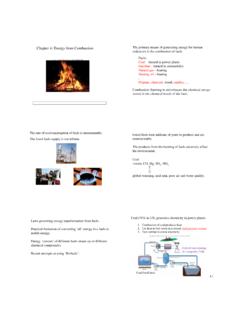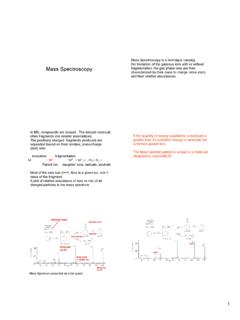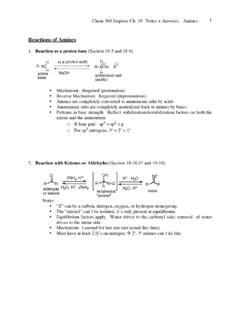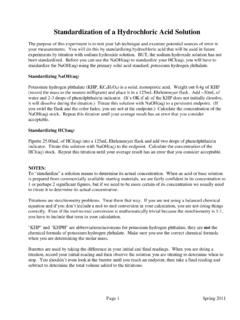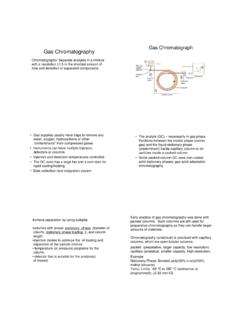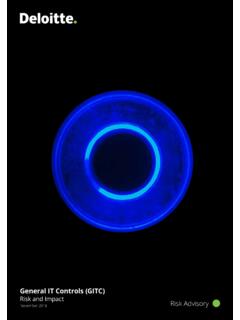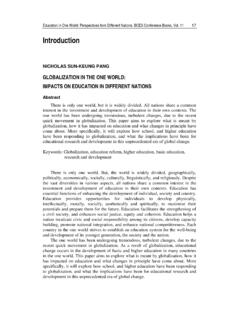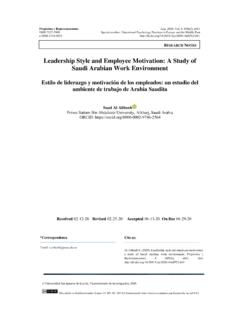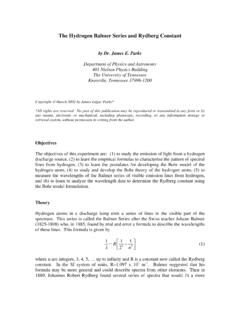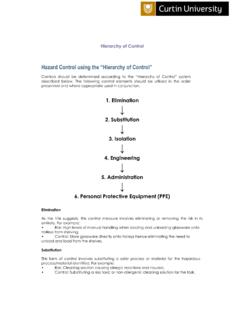Transcription of Practice Sets
1 Practice sets Organic Chemistry II Table of Contents Online Organic Chemistry II, Chem 360, Dr. Craig P. Jasperse, Minnesota State University Moorhead For full class website, see Fall/spring: Summer: Face: Test Page Test 1 PS#1: Arrow-Pushing/Mechanisms Practice Set 3 Test 1 PS#2: Acid Base Practice Set 7 Test 1 PS#3: Alcohol-related Mechanisms Problems 11 Test 1 PS#4: Alcohol-Related Retrosynthesis Problems 15 Test 2 PS#1: Jasperse NMR Problems (this will only show the first ten or 42. It will have link to the full 42-problem Practice set, which are also included in the class notes. 17 Test 3 PS1: Mechanism Practice (Many) 27 Test 3 PS2: Retrosynthesis + Synthesis Design Practice 35 Test 4 PS1: Acid-Base Practice 1 (Easy, basics) 39 Test 4 PS2: Acid-Base Practice 2 (Harder, more test representative) 43 Test 4 PS3: Mechanisms, Retrosynthesis + Synthesis 45 12 1 Chem 360 Name: Jasperse Quiz (mechanisms) Due: Arrow-Pushing Practice , Page 1: Draw arrows for each of the steps in the following reactions.)
2 I won t require this on tests, but you may find it useful to include all lone-pairs on atoms that react. I won t require this on tests, but you may find it useful to draw in all hydrogens on atoms that react. (It is not useful to draw in all H s on atoms that don t react.) Remember that arrows track the movement of electrons, so an arrow should go from the source of electrons and point directly to the atom that accepts them. BrHHBrE2 OHBrSN1E1 NaII+NaBr+SN2 HHH+NaOH+HOH+NaBrO+ Br-H2O+ HHHBr+ BrH2 OHH+ H3 OHHHHOHOHOH2 OHH+ H-Br(Old Test) 3 Test 1 PS#1: Arrow-Pushing/Mechanisms Practice Set 2 Page 2: Draw the arrow(s) for each of these steps.
3 1. OHH+OH2 2. OH2+ H2O 3. HHH+H2O+ H3O+ 4. PhBrPh+ Br+_ 5. PhBrPh+ Br_OHOH_ 6. PhPh+ Br_D-BrD+ 7. Ph+ Br_D+PhDBr 8. HOCH3 HOCH3 HHOHCH3 9. OCH3_OOCH3O_ 10. PhPh+ Cl_Br-ClBr+PhBrCl 11. HNEt3++ Br_HBrHHNEt3+ 4 Test 1 PS#1: Arrow-Pushing/Mechanisms Practice Set 3 For each of the following reactions, write whether the mechanism would be radical, cationic, or anionic? 1. HNO3NO2 2. BrO2 NNaOHOHO2N 3. HOCH3OH, H+HOCH3H3CO 4. Br2, peroxidesBr 5. OBr2, NaOHOBr 6. H2O, H+OOHOH 7. peroxidesetcetc 8. OOCH3H3 COH2O, H+ 9. OLiCH3 OLiCH3 5 Test 1 PS#1: Arrow-Pushing/Mechanisms Practice Set 4 Some Arrow-Pushing Guidelines 1.
4 Arrows follow electron movement. 2. Some rules for the appearance of arrows The arrow must begin from the electron source. There are two sources: a. An atom (which must have a lone pair to give) b. A bond pair (an old bond that breaks) An arrow must always point directly to an atom, because when electrons move, they always go to some new atom. 3. Ignore any Spectator Atoms. Any metal atom is always a spectator When you have a metal spectator atom, realize that the non-metal next to it must have negative charge 4. Draw all H s on any Atom Whose Bonding Changes 5. Draw all lone-pairs on any Atom whose bonding changes 6. KEY ON BOND CHANGES.
5 Any two-electron bond that changes (either made or broken) must have an arrow to illustrate: where it came from (new bond made) or an arrow showing where it goes to (old bond broken) 7. Watch for Formal Charges and Changes in Formal Charge If an atom s charge gets more positive it s donating/losing an electron pair arrow must emanate from that atom or one of it s associated bonds. There are two more positive transactions: When an anion becomes neutral. In this case, an arrow will emanate from the atom. The atom has donated a lone pair which becomes a bond pair. When a neutral atom becomes cationic. In this case, the atom will be losing a bond pair, so the arrow should emanate from the bond rather than from the atom.
6 If an atom s charge gets more negative it s accepting an electron pair an arrow must point to that atom. Ordinarily the arrow will have started from a bond and will point to the atom. 8. When bonds change , but Formal Charge Doesn t change , A Substitution is Involved Often an atom gives up an old bond and replaces it with a new bond. This is substitution . In this case, there will be an incoming arrow pointing directly at the atom (to illustrate formation of the new bond), and an outgoing arrow emanating from the old bond that breaks 6 Test 1 PS#1: Arrow-Pushing/Mechanisms Practice SetOrganic Chemistry Jasperse Acid-Base Practice Problems A.
7 Identify each chemical as either an acid or a base in the following reactions, and identify conjugate relationships. -You should have one acid and one base on each side -You should have two conjugate pairs 1. 2. 3. 4. 5. B. Choose the More Basic for Each of the Following Pairs (Single Variable). You can use stability to decide. 6. NH3 NaNH2 7. NaOH H2O 8. 9. 10. 11. CH3CH2OH + NaOHCH3CH2 ONa + H2 OCH3CH2 NHLi + CH3 OHCH3CH2NH2 + CH3 OLiCH3CH2CO2H + CH3 MgBrCH3CH2CO2 MgBr + CH4CH3OH + H3O+H2O + CH3OH2+CH3CH2NH3+ + CH3 OHCH3CH2NH2 + CH3OH2+NHONHNaONaPhOPhOONHNaNHNaO7 Test 1 PS#2: Acid Base Practice Set C.
8 Rank the basicity of the following sets : Multiple Variable Problems 12. CH3 MgBr CH3 NHNa CH3NH2 13. 14. 15. D. Choose the More Acidic for Each of the Following Pairs: Single Variable Problems 16. 17. 18. 19. 20. 21. OOOOHNHNaONaOOHONaNHOOOHONH3NH4OH2 OHOHNH2CH3NH2 OHOHOHONH2NH2O8 Test 1 PS#2: Acid Base Practice SetE. Rank the acidity of the following sets : Multiple Variable Problems 22. 23. 24. 25. 26. F. Draw arrow to show whether equilibrium favors products or reactants. (Why?) 27. 28. G. For the following acid-base reaction, a. put a box around the weakest base in the reaction b.
9 Put a circle around the weakest acid c. draw an arrow to show whether the equilibrium goes to the right or left. (4pt) 29. OH2 OOHOOHHFNH2NH3 OOHOH2 OOHNH2 OHOOHNH2NH3 ONH2 OOHNH2 HeOOHOH2O +OH +HOHOHOOONH2 OHNH++ONaNH2 NHNaOH++9 Test 1 PS#2: Acid Base Practice SetChem 341 Jasperse Ch. 1 Structure + Intro 12 Acid-Base Chemistry (Section ) Acidity/Basicity Table Entry Class Structure Ka Acid Strength Base Base Strength 1 Strong Acids H-Cl, H2SO4 102 2 Hydronium H3O+, ROH+ cationic 100 H2O, HOR neutral 3 Carboxylic Acid 10-5 4 Ammonium Ion (Charged) 10-12 5 Water 10-16 6 Alcohol 10-17 7 Ketones and Aldehydes 10-20 8 Amine (N-H) (iPr)2N-H 10-33 9 Alkane (C-H) 10-50 Quick Checklist of Acid/Base Factors 1.
10 Charge 2. Electronegativity 3. Resonance/Conjugation When neutral acids are involved, it s best to draw the conjugate anionic bases, and then think from the anion stability side. The above three factors will be needed this semester. The following three will also become important in Organic II. 4. Hybridization 5. Impact of Electron Donors/Withdrawers 6. Amines/Ammoniums ClOSOOHO,ROHOROORNRHRC harged, but onlyweakly acidic!RNRRN eutral, but basic!HOHHOROHROO!HO!(iPr)2N LiRCH3 RCH210 TTTBaseStabilityText1. Cations more acidic than neutrals; anions more basic than neutrals2. Carbanions < nitrogen anions < oxyanione < halides in stability3. resonance anions more stable than anions without resonanceTest 1 PS#2: Acid Base Practice SetOrganic(Chemistry(2((Jasperse((Test(1 ,(Alcohol(Chemistry((Draw(Mechanisms(for (the(Following(Reactions((1.)))))))))))) ))))))
